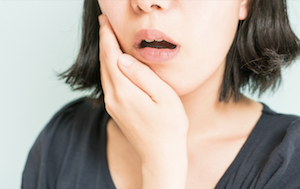Every day people find themselves rushing around trying to do two or three things at once. You’re on the phone scrambling while trying to do a two handed task with only one free hand. You finally realize that you cannot manage, so you squeeze your shoulder up to your ear to support your phone. Voila- your hands are free and you are able to complete your task.

All too often this scenario occurs for those working at a desk job. You are speaking on the phone but then need to type something out. Next thing you know, you are holding your phone with your shoulder. Others find themselves using this technique during meal prep. You’re trying to multitask when catching up with family or friends after a long day. Without thinking, your shoulder is now cradling your phone so you can use both hands to make dinner.
Holding your phone between your shoulder and head has always been a quick and easy strategy. Although never a good idea, it was a more manageable task when phones were much larger than they are now. You only had to lift your shoulder and lean your head a small amount to hold those bulky land line phones. Having to support a cell phone is much more challenging due to their very thin shape. To do so, you have to make a much more dramatic move with both your shoulder and your head.
Why Holding Your Phone Can Cause TMJ Symptoms
To hold your phone like this for even a short phone call can be quite irritating to your neck and TMJ. You may have noticed that you feel like you need to switch between shoulders to get some relief. Or you may even take breaks from cradling so that you can stretch your neck and shoulder. For those that are doing this all day, every day, the results can be devastating.
This can be incredibly irritating to the muscles and joints of your neck, upper back, and shoulder. The muscle that is probably most noticeably angry to you is your upper trapezius. This is the large muscle that spans from your shoulder through your neck and up to the base of your skull. You’ve likely tried rubbing to relax this muscle because “this is where you hold your stress”. Any headaches you are experiencing may be due in part to the increased upper trap tension you have created.

Some of you may even notice soreness through your jaw when talking with a phone pinched up to your ear. You may feel tension spanning from your jaw joint down through your cheek. You may even feel a slight clicking in your jaw or ear as you say certain words. That is because your jaw moves in a different pattern when your head is tilted to the side!
If you are not one to typically cradle your phone and you are in a situation that you need to, don’t be afraid! Yes, you may feel tension or discomfort afterwards, but this shouldn’t be something that causes a lifetime of neck or jaw pain. Now, if you are the person described earlier that is doing this every day, it’s in your best interest to make a change!
What To Do About It
There are many, very easy to manage strategies out there to reduce this stress on your neck, shoulder, and jaw. These alternatives include headphones, headsets, or even the use of speaker phone. I understand that these are not feasible in every situation, but if you are on the phone while making dinner, why not put it on speaker phone? If you are on a private call or are at work, take the two seconds to get your headphones out.

Making this simple change can save you a lifetime of pain, stress, and aggravation. If you recognize that you are one to hold your phone with your shoulder, do yourself a favor and get those headphones out!
For employers, if you see someone in your office cradling their phone, it is in your best interest to speak up and help him or her make the change. This simple strategy will reduce headache days and improve productivity!
If you have questions about how to manage your orofacial pain, neck pain, or headaches, please feel free to reach out via email, phone, or find us on Instagram and Facebook. Check out our other blogs for more helpful TMD management tips!


